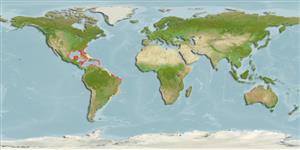Common names from other countries
Environment: milieu / climate zone / depth range / distribution range
экология
ассоциированный с рифами; солоноватоводный; пределы глубины 2 - 76 m (Ref. 108813). Tropical
Western Atlantic: Caribbean and Gulf of Mexico.
Length at first maturity / Size / Вес / Возраст
Maturity: Lm ? range ? - ? cm Max length : 5.0 cm OT самец/пол неопределен; (Ref. 415)
Thick encrusting; 1 - 5 cm to massive amorphous. Black to dark brown or tan externally on parts unexposed to light, tan internally. Tough, firm, and cartilaginous (Ref. 415).
Maximum thickness: 5 cm (Ref. 415). Occasionally found on mangrove roots and peat banks. Common on reefs and lagoons (Ref. 415). Found on rocky substrates (Ref. 83912). Inhabits seagrasses, mangroves, coralline algae reefs, algal nodules, lower mesophotic and heavily silted reefs (Ref. 128739).
Life cycle and mating behavior
половая зрелость | размножение | нерест | икра | Fecundity | личинки
Members of the class Demospongiae are hermaphroditic. Life cycle: The zygote develops into parenchymella larva (free-swimming) before settling down on a substrate where it grows into a young sponge.
Основная ссылка
ссылки | координатор | соавторы
Collin, R., M.C. Díaz, J. Norenburg, R.M. Rocha, J.A. Sánchez, M. Schulze, A. Schwartz and A. Valdés. 2005. (Ref. 415)
Статус Красного Списка МСОП (Ref. 130435)
Статус СИТЕС (Ref. 108899)
Not Evaluated
Not Evaluated
Использование человеком
| FishSource |
инструменты
дополнительная информация
Возраст/РазмерыростЗависимость между длиной и массой телаЗависимость между длинамиморфологияличинкичисленность
ресурсы в Интернет
Estimates based on models
Preferred temperature
(Ref.
115969): 23 - 28, mean 26.1 (based on 296 cells).
Уязвимость
Low vulnerability (10 of 100).
Категория цены
Unknown.
